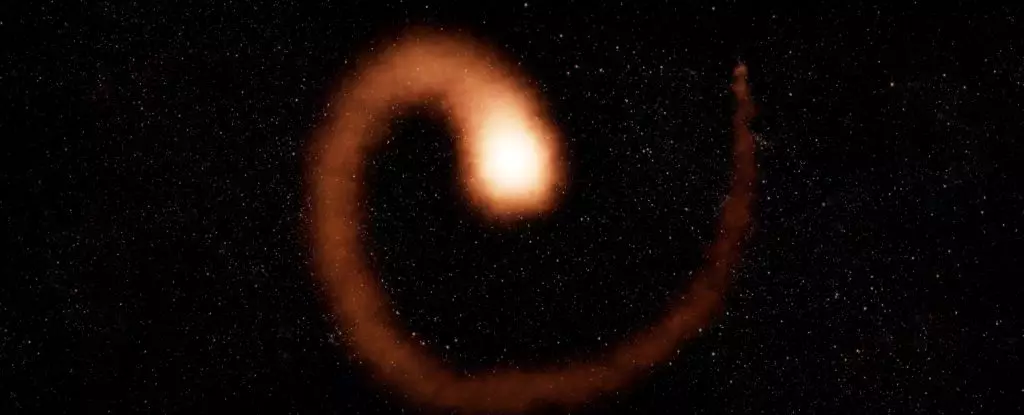In the depths of the universe, a mesmerizing spectacle unfolds in what is known as the Wolf-Rayet 104 (WR 104) system. Positioned roughly between 2,000 to 11,000 light-years from Earth, this been nicknamed the Pinwheel Nebula—a striking manifestation of stellar death that reveals not only the beauty of the cosmos but also the complexity of celestial dynamics. The tale of WR 104 serves as a reminder that the universe is loaded with secrets and surprises that continually defy our expectations.
At first glance, WR 104 appears like a simple binary star system with a dying star at its core. However, the jewel of this cosmic system lies in its unexpected features, particularly the intriguing shape of the nebula. The two massive stars—one a Wolf-Rayet and the other an OB star—engage in a gravitational dance, directing the ejected materials into a visually stunning spiral. This interaction showcases the complex relationships between celestial bodies and how they sculpt the universe around them, all while ushering in the final act of their fiery lives.
Understanding Wolf-Rayet Stars
Wolf-Rayet stars are a rare class of stars characterized by their massiveness, extreme luminosity, and ultimately short life spans, lasting only about a few million years. The WR 104 star is approximately 13 solar masses. Their lifecycle is marked by intense mass loss, driven by radiation pressure that results in high-velocity stellar winds—the very winds that also sculpt the surrounding materials into intricate structures like the Pinwheel. These phenomena provide valuable insights into stellar evolution and the end stages of massive stars.
As a Wolf-Rayet star reaches the end of its life, it sheds layers of material that eventually result in breathtaking formations in space. However, the long-term implications of these cosmic events raise critical questions. Astronomers have long speculated about the potential dangers posed by nearby Wolf-Rayet stars, particularly the threat of gamma-ray bursts resulting from supernova explosions—a critical concern due to their capacity to devastate planetary atmospheres.
Gamma-ray Bursts and Their Threat to Earth
One essential aspect of the research surrounding WR 104 involved understanding the orientation of this cosmic spectacle in relation to our planet. Initially, predictions suggested that the system’s poles were aligned with Earth, an alarming scenario considering the implications of a gamma-ray burst. Such an alignment could release lethal radiation capable of stripping away our ozone layer and potentially triggering extinction-level events.
Fortunately, recent discoveries led by astronomer Grant Hill and his team at the Keck Observatory have alleviated those fears. By analyzing data spanning over two decades, they uncovered that the binary stars’ orbit is tilted at roughly 30 to 40 degrees relative to our line of sight. This means that if a gamma-ray burst occurs, it will veer off into the void rather than striking Earth directly. Thus, humanity can breathe a sigh of relief, at least for the moment—WR 104’s explosion isn’t on the verge of happening, projecting an event several hundred thousand years away.
A Cosmic Conundrum: Alignments and Misalignments
However, as is commonplace in astronomical study, new questions emerge even as old ones are resolved. Despite the bright side of not facing an immediate catastrophic threat, scientists are left puzzled by a different enigma: the apparent misalignment of the bubble of dust created by these stellar winds. While the spiral structure of WR 104 seems oriented directly towards Earth, how it can maintain such a shape with the stars’ misaligned orbital plane remains poorly understood. Such mysteries reflect the paradoxes that often arise in astronomical research, where each new answer gives birth to further inquiries.
The challenging nature of this phenomenon reveals one of the most profound aspects of science—our expanding understanding is often accompanied by layers of complexity that resist simplification. As Hill aptly points out, the universe is constantly surprising us, revealing extraordinary mysteries hidden within its boundless expanse.
Exploring Cosmic Interactions
The dynamics of WR 104 not only highlight the stunning beauty of celestial phenomena but also serve as a critical reminder of the interconnectedness of cosmic bodies. Stellar winds don’t merely define individual stars; they actively sculpt the cosmic fabric around them. Understanding these interactions helps to forge connections between perceived chaotic events in the universe, leading to greater insights into the principles governing stellar evolution and the lifecycle of galaxies.
The spectacle of WR 104, complete with its precarious dance of death and rebirth, invites us not just to observe the universe but to engage with the profound intricacies that come with unraveling celestial enigmas. As the boundaries of knowledge stretch, we stand on the cusp of awe-inspiring discoveries that serve to deepen our appreciation for the cosmos. The journey through the mysteries of the universe, especially those revealed in systems like WR 104, promises more secrets waiting to be unearthed, challenging our perceptions of existence itself.


Leave a Reply